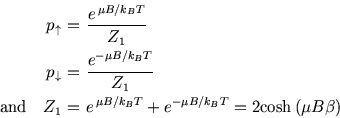The starting point is the Boltzmann probabilities for the two energy states of a single spin,
![]() and
and
![]() :
:

In this simple case both the average energy and magnetisation of a single spin can be found directly from the probabilities:


But for things like the entropy which only makes sense for the whole system, and as a warm-up for more complicated cases, we can use the partition function method instead; the results for the energy and magnetisation are the same.
We also have